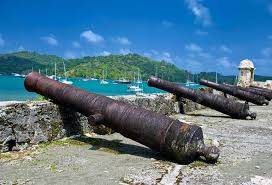Panama Develops Sustainable
Tourism in Portobelo
Source; Özgür Töre FT NEWS
Located in the province of Colon,
Portobelo is a Caribbean jewel where the UNESCO World Heritage designation
converges both for its colonial fortifications and for the Congo culture, also
declared as an intangible world heritage site by UNESCO.
Legend has it that this beautiful
bay was originally named by Christopher Columbus as “Puerto Bello”; with iconic
activities from Panama’s Green (nature), Blue (oceans) and Cultural Heritage
experiences such as the Portobelo National Park, the Portobelo Bay and historic,
colonial buildings including the Portobelo Customs House, the region is
brimming with tourism adventures to satisfy any travelers’ wanderlust.
In an effort to expand these
tourism offerings, the Panama Tourism Authority (ATP), in partnership with the
Ministry of Culture and the Ministry of Environment, is currently executing
restoration projects to enhance the areas of Portobelo and San Lorenzo, which
are part of Panama’s Master Plan for Sustainable Tourism. Several projects are
being implemented, including the following:
The rehabilitation of the old
structures of the Portobelo Customs House and the San Lorenzo Castle, both
museums that tell the story of Portobelo’s history, spearheaded by the Ministry
of Culture with financing from the Inter-American Development Bank (IDB).
The education and training of
local tour guides, in preparation of the reactivation of tourism. To date, the
ATP and the Ministry of Environment recently certified 20 local tour guides.
Rehabilitation of the Historic
Center of Portobelo, both the cultural and natural part, which will be
developed in conjunction with the Ministry of Culture, which includes the
rehabilitation of the Tourist Facilities and Interpretation Center (CEFATI),
owned by the ATP.
Rehabilitation of trails in
Portobelo National Park, famous for its beautiful Caribbean views and
waterfalls, which will be added to the 1,000 Km of Trails project, as well as
the training of site guides to enhance the natural heritage. One of its most
iconic trails is the “Camino Real” (King’s Road), an interoceanic trail where
gold and other precious metals where transported in colonial times from the
Pacific Ocean, ending in Portobelo in the Caribbean Sea, recognized by National
Geographic among the 50 best tours of a lifetime.
The support of conservation
projects such as, “Rescuing Portobelo's Coral Colony” aimed at rescuing the
coral reefs in the Bay of Portobelo, a popular tourist destination for
snorkeling and scuba diving.
“We are proud to announce the implementation of our Tourism-Conservation-Research (TCR) strategy in Portobelo,” said Ivan Eskildsen, Panama’s Minister of Tourism.
“Placing local communities at the
center of sustainable tourism, we are working to restore and preserve this
UNESCO World Heritage Site full of fascinating history, and extraordinary
biodiversity, both in its oceans and its rainforests. We look forward to
attracting the discerning travelers of the post-pandemic world, eager to
discover authentic experiences with historical depth and scientific importance.”
Aimed at reducing the social
inequality gap through community empowerment, training plans are being
developed for local residents and incentives for entrepreneurship with seed
capital, which is linked to the community tourism plan implemented by the ATP.
The projects, which represent an investment of $44.6 million, are also designed
to remove both Portobelo and San Lorenzo from the UNESCO list of World Heritage
in danger.
This is another example of how
Panama is implementing the Master Plan for Sustainable Tourism, recently
recognized by UNESCO as an example of innovation and sustainability,
highlighting Panama's natural and cultural heritage. The plan reactivates
Panama’s Tourism, Conservation and Research (TCR) strategy applied in Panama over
20 years ago by the prestigious ecologist Dr. Hana Ayala. The TCR’s heritage
routes strategy was updated to focus on three core areas: Cultural Heritage
(multifaceted culture), Green Heritage (unique biodiversity) and Blue Heritage
(ocean wonders).

